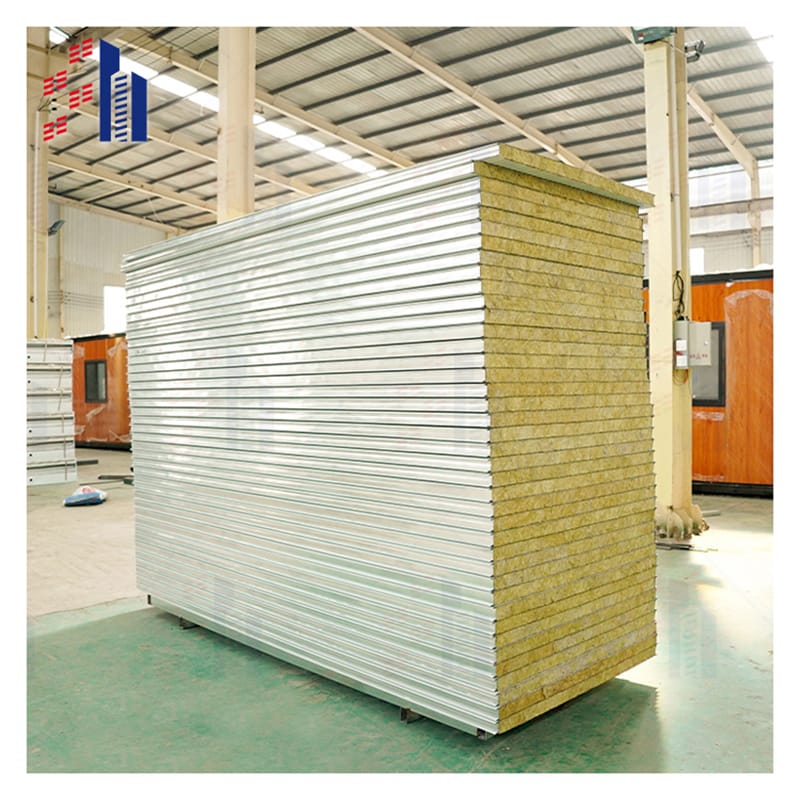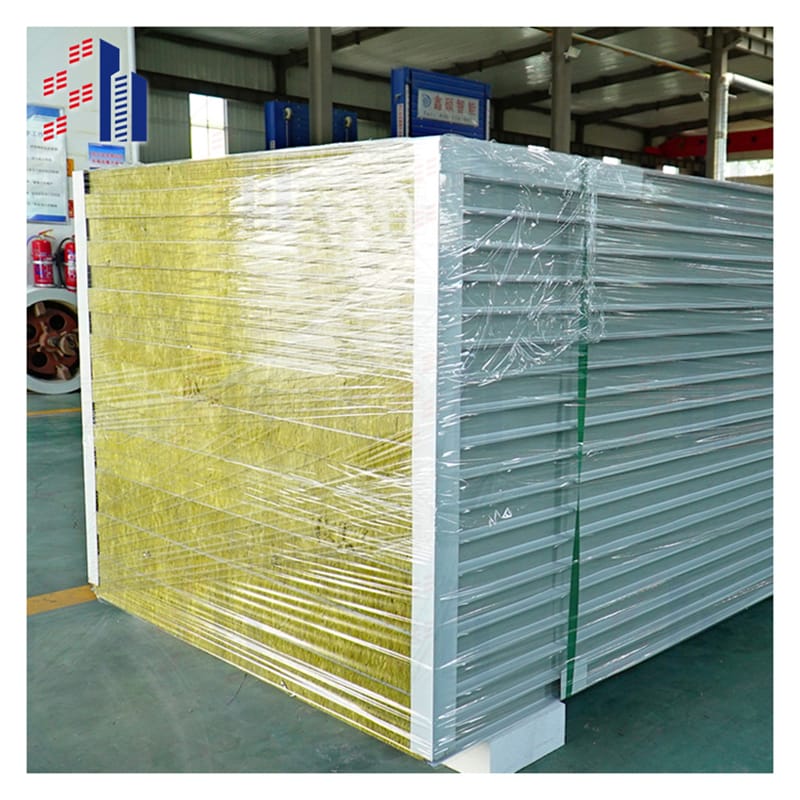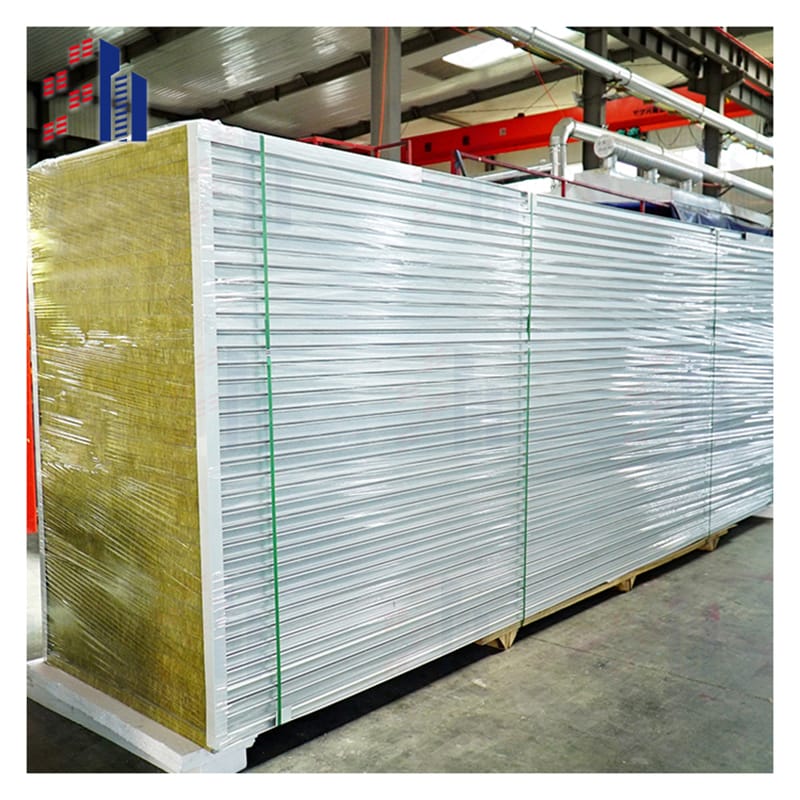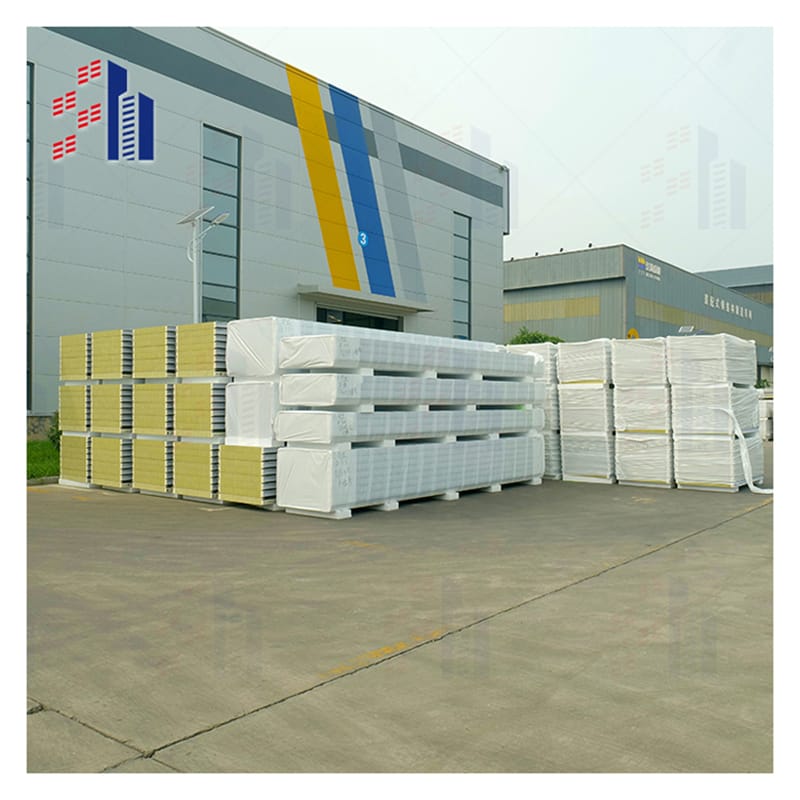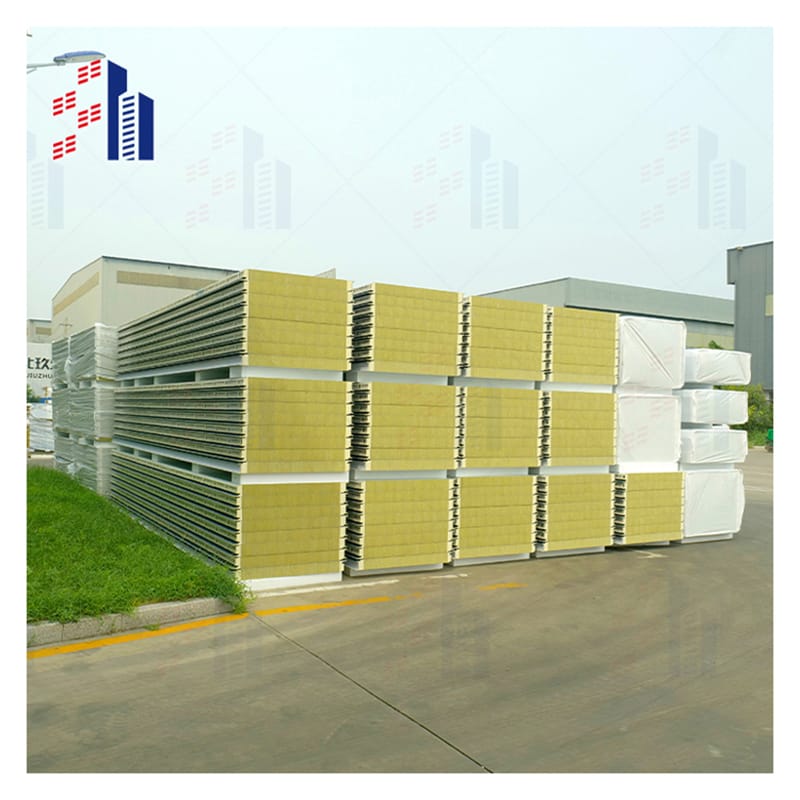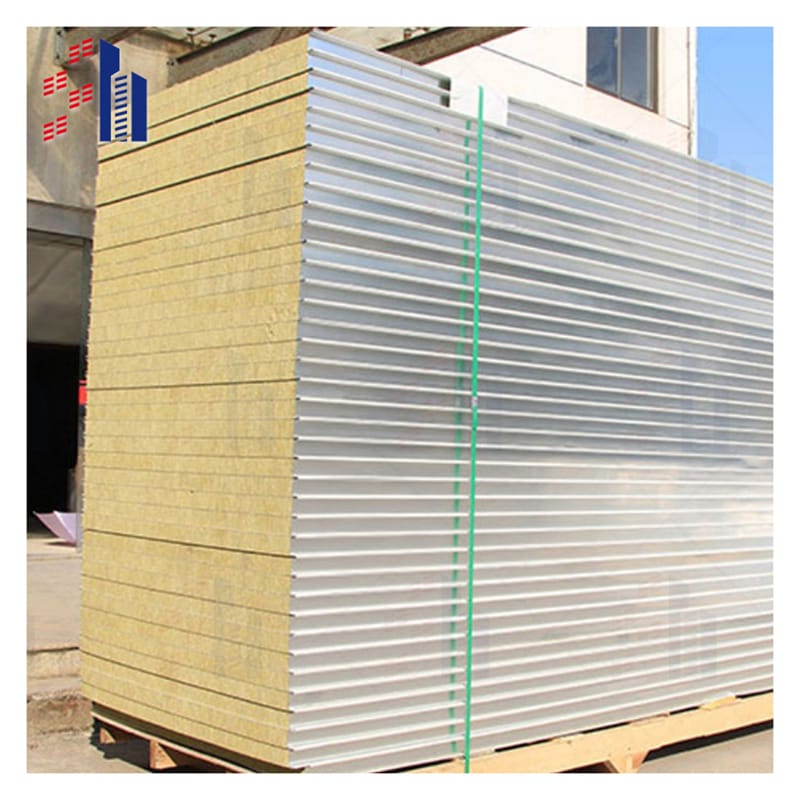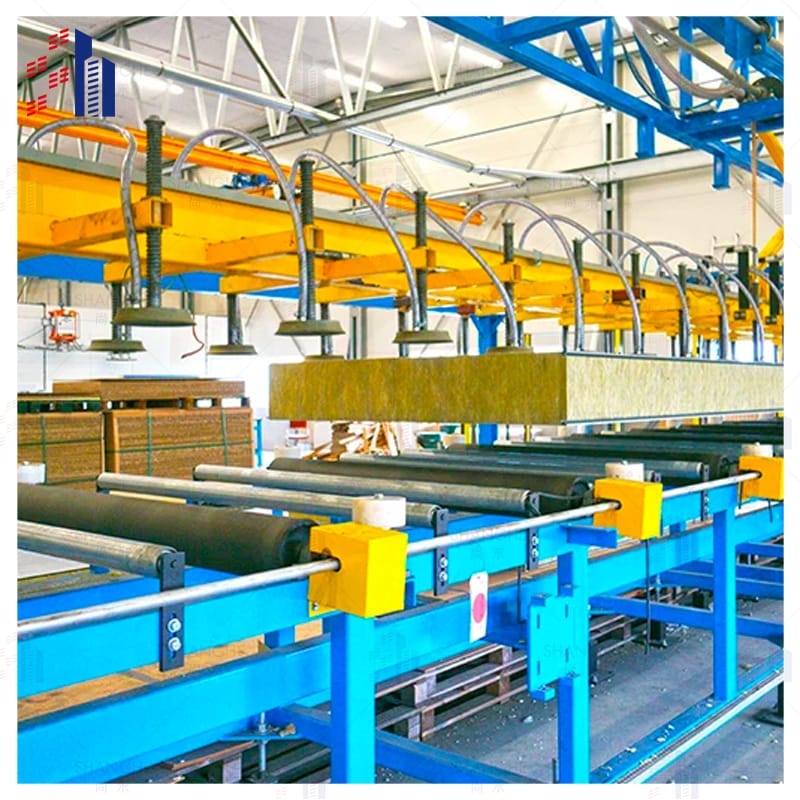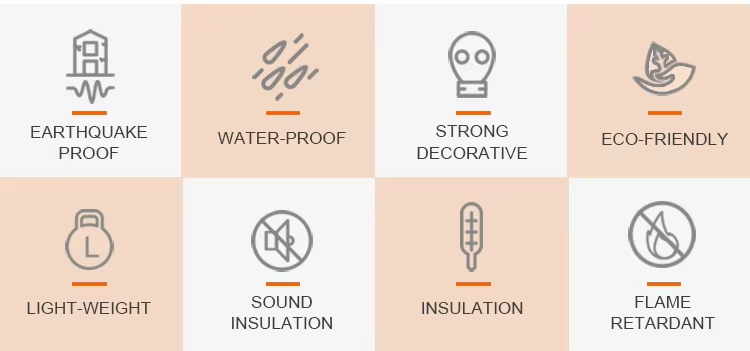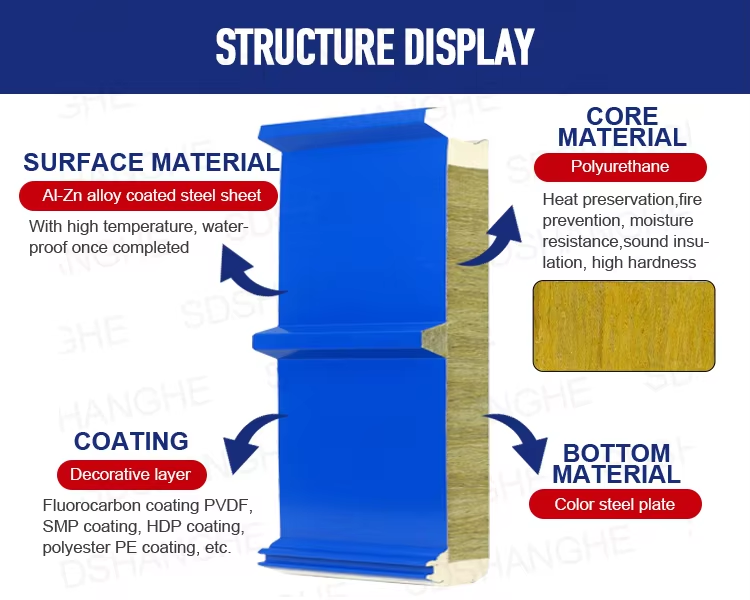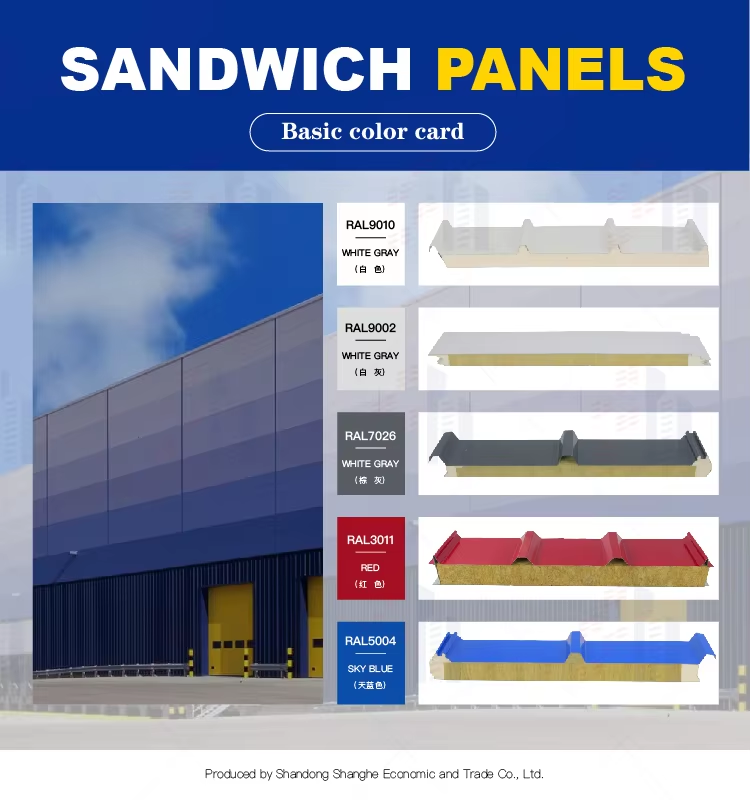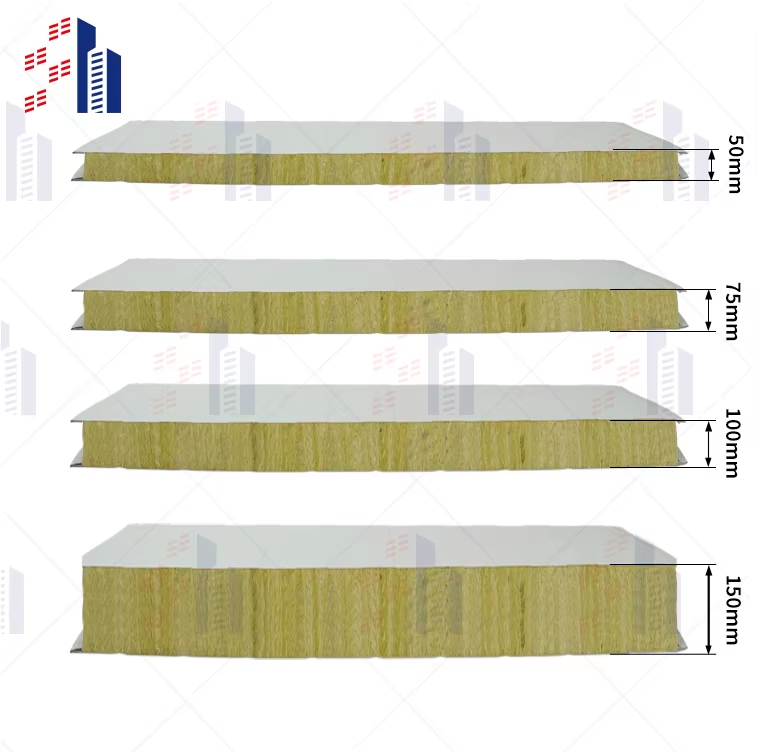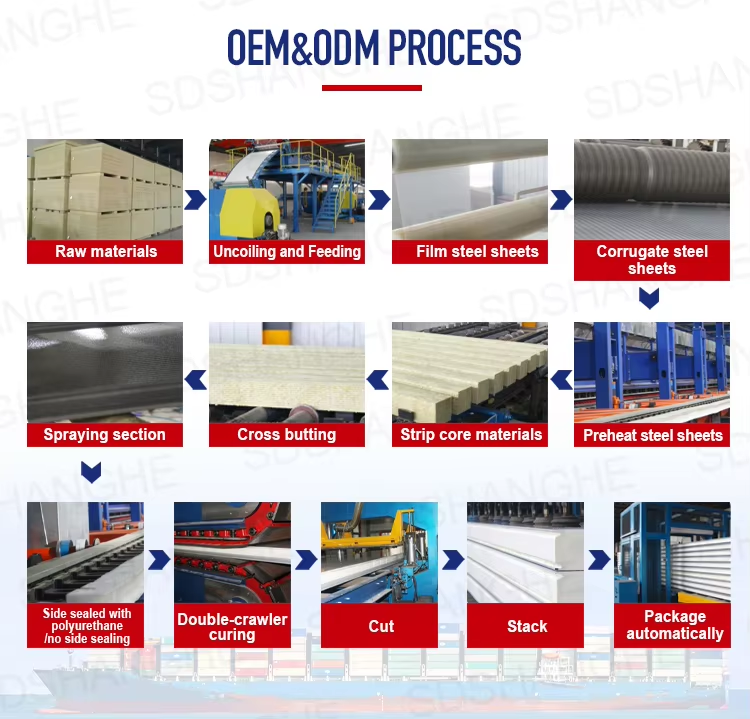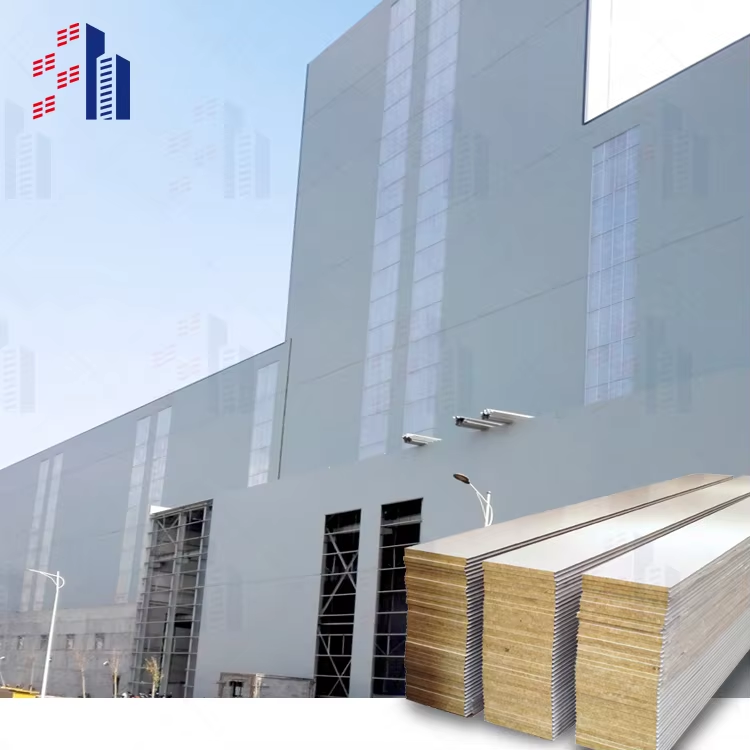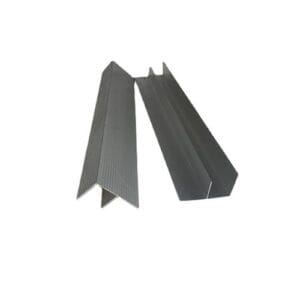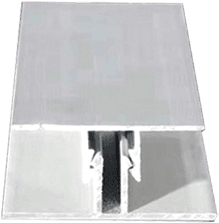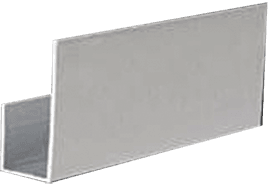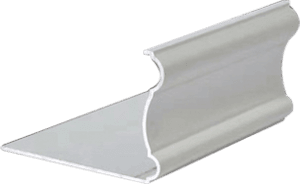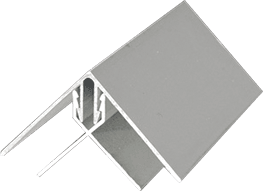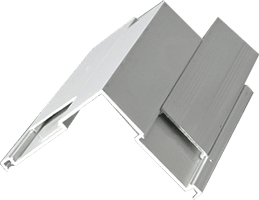What Are Foam Core Sandwich Panels
Foam core sandwich panels are composite structural panels made by bonding two thin, stiff face sheets to a lightweight foam core. This innovative sandwich panel construction delivers an outstanding combination of high strength, low weight, and enhanced stiffness, making them ideal for a variety of demanding applications.




Customers visit the factory





Installation details
Key Specifications
| Parameter | Specification | Why It Matters |
|---|
| Face Material | 6-12mm Fiber Cement Board (Density: 1.6g/cm³) | Thinner = lighter weight; Thicker = higher impact resistance. |
| Core Material | Mineral Wool (A1 Fireproof) or PIR Foam (B1 Fire-rated) | A1 = No burning; B1 = Lightweight + insulation. |
| Fire Rating | ASTM E136 (U.S.) / EN 13501-1 (EU) / GB 8624 (China) – Class A1 | Required for high-rises, hospitals, and factories. |
| Thermal Conductivity (λ) | 0.038 W/m·K (Mineral Wool) / 0.022 W/m·K (PIR) | Lower λ = Better insulation (cuts HVAC costs). |
| Load-Bearing Capacity | Up to 150 kPa (Compressive Strength) | Handles heavy wind/snow loads for roofs and walls. |
| Water Resistance | ≤0.5% Water Absorption (ASTM C1185) | No swelling or mold in humid climates. |
| Size Options | Standard: 1220x2440mm / Custom: Max 4000mm length, 50-200mm thickness | Fits modular construction needs. |
| Surface Finish | Smooth, Woodgrain, or Custom Coating (Fade-resistant) | Aesthetic flexibility for architects. |
| Installation | Tongue-and-Groove or Aluminum Rail System | No specialized tools needed; 50% faster than brick. |
Important attributes |
| design | the present age | After-sales service | Online Technical Support, Other |
| Origin | Shandong, China | Application Scenarios | Warehouse |
| Brand | SH | Warranty Service | polyurethane |
| Panel Material | polyurethane | Models | SH 150mm |
| Usage | Exterior Decoration | Product Name | Sandwich Panel Uae |
| Surface Material | Metallic | Minimum Order | Personalization |
| Thickness | 16MM/20MM/25MM | Color | Bright red, vermillion, lime, sky blue, aquamarine, pea green or customized |
| Width | 100mm,120mm,150mm,200mm | | |
Core Materials and Their Properties
The foam core is the heart of these panels, providing bulk thickness and insulation while keeping weight minimal. Common foam core materials include:
Polyurethane (PU) Foam
High compressive strength and excellent thermal insulation. Ideal for aerospace and transportation due to superior durability.
Polyvinyl Chloride (PVC) Foam
Good strength-to-weight ratio with superior chemical resistance and moisture tolerance. Widely used in marine and construction industries.
Polyethylene Terephthalate (PET) Foam
Recyclable, flame-retardant, and moisture resistant. Great for sustainable projects needing fire safety compliance.
Expanded Polystyrene (EPS) Foam
Lightweight and cost-effective, offering good thermal insulation but lower mechanical strength compared to others.
Extruded Polystyrene (XPS) Foam
Dense, water-resistant, and with better structural integrity than EPS, commonly used for roofing and insulation panels.
Each foam type has unique mechanical and insulation properties, enabling customization to specific project needs such as load requirements, thermal resistance, and moisture exposure.
Face Sheet Materials
The exterior face sheets are crucial to the panel’s strength and durability. Typical face sheet materials include:
Fiberglass Reinforced Plastic (FRP)
Lightweight, corrosion-resistant, and offers moderate strength. Common in marine and transportation sectors.
Carbon Fiber
Extremely high stiffness and strength with lightweight properties, suitable for aerospace and high-performance applications.
Stainless Steel
Durable, corrosion-resistant, and ideal for harsh environments requiring high impact resistance.
Aluminum
Light and corrosion-resistant, offering good strength for structural use in construction and transport.
How the Sandwich Structure Enhances Strength and Stiffness
The sandwich panel design significantly improves the strength-to-weight ratio and flexural stiffness compared to solid materials of the same weight. Here’s how:
- The thin stiff face sheets handle tensile and compressive forces, preventing bending or deformation.
- The foam core acts as a spacer, maintaining the distance between the face sheets and resisting shear forces.
- This combination means the panel can withstand higher loads and resist flexing or warping without adding significant weight.
Result: A lightweight, high-strength panel ideal for industries that demand strong, durable, and lightweight composite panels—like aerospace, marine, construction, and transportation.
In , foam core sandwich panels combine advanced foam core materials with stiff face sheets like fiberglass or aluminum to deliver lightweight, durable, and high-performance solutions with excellent strength and stiffness. Whether you need thermal insulation, corrosion resistance, or structural integrity, these panels offer a customizable, efficient option.
Key Benefits of Foam Core Sandwich Panels
Foam core sandwich panels offer a range of advantages that make them a smart choice for many projects across industries in the United States. Here’s why these lightweight composite panels stand out:
Lightweight Yet High Strength
One of the biggest benefits of foam core sandwich panels is their excellent strength-to-weight ratio. Thanks to the sandwich panel construction—thin but stiff face sheets bonded to a lightweight foam core—they deliver high structural strength without the heavy weight. This makes them perfect for applications where saving weight is essential, such as aerospace components, marine vessels, and transportation vehicles.
Superior Thermal and Acoustic Insulation
The foam core material acts as an efficient thermal barrier, providing outstanding insulation properties to help keep buildings, vehicles, and equipment energy efficient. At the same time, these panels reduce sound transmission, making them ideal for environments demanding noise control, from commercial construction to aircraft interiors.
Corrosion Resistance and Durability
When combined with face sheets like stainless steel or fiber-reinforced plastics (FRP), foam core sandwich panels exhibit excellent resistance to corrosion and weathering. This durability extends the panel’s lifespan, especially in harsh environments such as marine or industrial settings, reducing maintenance costs and downtime.
Cost Effectiveness Compared to Alternatives
Foam core sandwich panels are often more affordable than other types of structural sandwich panels, like honeycomb cores or solid panels. Their cost-effectiveness comes from easier manufacturing, less expensive core materials like polyurethane or PVC foam, and reduced handling due to their light weight—helping keep project budgets in check.
Versatility Across Multiple Industries
Thanks to their customizable core types and face sheets, foam core sandwich panels are used across a wide range of industries, including:
- Construction: Wall panels, roofing, and insulation for energy-efficient buildings
- Aerospace: Interior components and overhead bins requiring lightweight solutions
- Marine: Boat hulls, decks, and bulkheads needing strength and corrosion resistance
- Transportation: Vehicle panels, trailers, and railcar components demanding durability and weight savings
This versatility makes foam core sandwich panels a go-to choice for designers and engineers wanting high-performance materials that adapt to various needs.
foam core sandwich panels combine lightweight construction, high strength, insulation, durability, and affordability, making them highly practical and reliable for a broad spectrum of applications in the U.S. market.
Applications of Foam Core Sandwich Panels
Foam core sandwich panels are widely used across multiple industries due to their lightweight structure, high strength, and excellent insulation properties. Here’s how they fit into key sectors in the United States:
Construction Industry
In construction, foam core sandwich panels serve as efficient wall panels, roofing, and insulation solutions. Their superior thermal performance helps create energy-efficient buildings, reducing heating and cooling costs. They also provide durability and improved sound insulation, making them ideal for both residential and commercial projects.
Aerospace Sector
Foam core sandwich panels are trusted for aircraft interiors, overhead bins, and various structural components. Their lightweight nature helps lower aircraft weight, directly contributing to fuel savings and improved performance. Materials like carbon fiber or fiberglass face sheets combined with foam cores meet the demanding strength-to-weight requirements of aerospace applications.
Marine Applications
In the marine industry, these panels are used for boat hulls, decks, and bulkheads. The combination of lightweight foam core and durable face sheets provides resistance against corrosion and water damage, enhancing the lifespan and seaworthiness of vessels. Their stiffness and strength help maintain structural integrity under tough marine conditions.
Transportation
Vehicle manufacturers use foam core sandwich panels for truck trailers, railcar panels, and other transportation components. These panels reduce vehicle weight, which improves fuel efficiency and payload capacity. They also offer vibration dampening and noise reduction, enhancing ride comfort.
Renewable Energy
Foam core sandwich panels are key in the renewable energy sector, especially for wind turbine blades and solar panel supports. Their lightweight build and high stiffness allow for larger, more efficient components that withstand harsh environmental conditions without adding unnecessary load.
Real World Case Studies
Shanghe’s foam core sandwich panels have a proven track record across these sectors, delivering on durability, insulation, and lightweight strength. For example:
- Construction: Shanghe’s panels have been used in energy-efficient commercial buildings, reducing energy demand while maintaining structural stability.
- Marine: Customized foam sandwich panels have enhanced boat hull longevity with minimal weight gain.
- Transportation: Shanghe’s panels contribute to lighter railcar bodies, improving fuel economy and reducing operational costs.
Explore more about our polyurethane foam sandwich panels and FRP sandwich panels to see which products fit your project needs.
By combining durability, lightweight design, and versatility, foam core sandwich panels represent a smart choice for industries focused on performance and efficiency.
Types of Foam Core Sandwich Panels by Shanghe
Shanghe offers a wide range of foam core sandwich panels designed to meet diverse application needs across industries. Our panels use high-quality core materials such as PVC foam, polyurethane foam, and PET foam, each selected for specific properties like strength, weight, and insulation.
Shanghe Foam Core Product Range
PVC Foam Core Panels
Known for good chemical resistance and durability, PVC foam core panels provide excellent structural performance with moderate weight. Ideal for applications requiring corrosion resistance and toughness.
Polyurethane Foam Core Panels
Offering superior thermal insulation and lightweight properties, polyurethane foam core is perfect for energy-efficient building panels and transportation sectors where weight saving is critical.
PET Foam Core Panels
PET foam cores are environmentally friendly and provide high stiffness with excellent recyclability. They are favored in applications needing both strength and sustainability.
Customization Options
We understand every project has unique demands, so Shanghe provides customization in:
- Core Density: Choose between low density for lightweight needs or high density for enhanced strength and load-bearing capacity.
- Core Thickness: Panels can be tailored from thin, lightweight cores to thick cores providing maximum insulation or structural stiffness.
- Face Sheet Materials: Options include fiberglass, carbon fiber, aluminum, stainless steel, and various composites to suit performance and aesthetic criteria.
Comparing Foam Types Low Density vs High Density
| Foam Type | Density Range | Strength | Weight | Typical Use |
|---|
| Low Density Foam | 30-80 kg/m³ | Moderate | Very Lightweight | Non-structural insulation, lightweight panels |
| High Density Foam | 80-250+ kg/m³ | High | Heavier | Structural panels, high-load applications |
Choosing the right foam density impacts stiffness, weight, and cost—critical factors for aerospace, marine, and transportation applications.
High Pressure Vacuum Composite Technology
A standout feature of Shanghe’s manufacturing is high pressure vacuum composite technology. This advanced process ensures:
- Superior Bonding between the foam core and face sheets
- Improved Panel Durability preventing delamination under stress
- Consistent Quality across batches with tight control over adhesion
- Ability to produce complex shapes and curved sandwich panels
This technology elevates our foam core sandwich panels, making them a reliable choice for demanding environments like aerospace interiors, marine hulls, and high-performance building facades.
For a closer look at some of our series, check out our PVC foam core sandwich panels and polyurethane sandwich panels.
Manufacturing Process and Quality Assurance of Foam Core Sandwich Panels
Advanced Production Techniques at Shanghe
At Shanghe, we utilize state-of-the-art manufacturing processes to produce foam core sandwich panels that meet the highest standards of strength, durability, and consistency. Our process starts with carefully selecting core materials like polyurethane, PVC, or PET foam based on the application needs. We then employ high-pressure vacuum composite technology, which ensures superior bonding between the foam core and face sheets such as fiberglass, carbon fiber, aluminum, or stainless steel. This method eliminates voids and weak spots, resulting in a panel with outstanding structural integrity and a superior stiffness-to-weight ratio.
Our automated production line also allows precise control of core density, thickness, and adhesive application, giving you uniform panel quality batch after batch. This process not only maximizes mechanical performance but also improves resistance to thermal expansion and moisture infiltration.
Rigorous Quality Control Measures
Quality assurance is critical to delivering reliable foam core sandwich panels. At every stage of manufacturing, we conduct strict inspections including:
- Dimensional checks for thickness, flatness, and edge straightness.
- Bond strength testing to confirm the core and face sheets are securely fused.
- Flexural and compressive strength evaluations tailored to your industry standards.
- Thermal and acoustic insulation performance tests when required.
We implement continuous monitoring to detect any defects early. This commitment ensures our panels consistently perform in demanding environments such as aerospace interiors, marine hulls, and energy-efficient building envelopes.
Certifications and Compliance
Shanghe’s foam core sandwich panels are designed and produced in accordance with recognized global standards. We hold certifications such as ASTM (American Society for Testing and Materials) and ISO 9001 quality management compliance. These certifications confirm that our panels meet or exceed performance criteria for safety, durability, and environmental regulations.
Our adherence to international standards assures customers across the United States and beyond that Shanghe foam core sandwich panels are trustworthy, reliable, and engineered for long-term use in critical applications.
Shanghe’s blend of advanced manufacturing technology, thorough quality controls, and trusted certifications makes our foam core sandwich panels a go-to solution for industries where lightweight strength and durability matter most.
Why Choose Shanghe for Foam Core Sandwich Panels
When it comes to foam core sandwich panels, Shanghe stands out for its strong focus on innovation and quality. We constantly improve our manufacturing technologies to deliver panels that meet the demanding needs of various industries across the U.S.
Commitment to Innovation and Quality
At Shanghe, we use advanced high pressure vacuum composite technology to ensure superior bonding between the foam core and face sheets. This results in panels that are not only lightweight but also high strength and durable. Every batch undergoes strict quality control to meet ASTM and ISO standards, so you get consistent, reliable performance.
Competitive Pricing and Fast Delivery
We understand that cost and timing matter. That’s why we offer competitive prices tailored for the U.S. market without compromising quality. Plus, our efficient supply chain means fast delivery anywhere in the country, supporting your project timelines and budgets.
Customization and Technical Support
Every project is unique. Shanghe provides extensive customization options including:
- Foam core types: polyurethane, PVC, PET
- Core density and thickness variations
- Face sheet materials like fiberglass, carbon fiber, aluminum, or stainless steel
Our experienced technical team guides you through selecting the right combination based on your application’s load requirements and environmental conditions, ensuring you get the ideal foam core sandwich panel solution.
Eco Friendly Options with Sustainable Foam Core Materials
We also prioritize sustainability. Shanghe offers eco-friendly panels made with recyclable foam cores and low-emission resins. These options support green building initiatives and reduce your project’s environmental impact without sacrificing performance or durability.
Choose Shanghe for foam core sandwich panels when you need trusted quality, tailored solutions, competitive pricing, and an environmentally responsible approach.
How to Select the Right Foam Core Sandwich Panel
Choosing the right foam core sandwich panel is crucial for getting the best performance and value for your project. Here’s what you need to keep in mind:
Consider Application and Load Requirements
- Structural Needs: Identify the load your panel will bear. Heavy load applications like flooring or marine decks require higher core density and thicker face sheets.
- Weight Sensitivity: For aerospace or transportation, where weight savings matter, opt for lightweight foam cores like PVC or polyurethane with carbon fiber or aluminum faces.
- Mechanical Stress: Assess if your panel will face bending, impact, or compression—this will guide your choice of core material and panel thickness.
Factor in Environmental Conditions
- Moisture Exposure: For humid or marine environments, use closed-cell foams like XPS or PVC foam cores, combined with corrosion-resistant face sheets such as fiberglass or stainless steel.
- Temperature Range: Polyurethane foam offers better thermal insulation for extreme temperatures, ideal for construction or renewable energy sectors.
- Chemical Exposure: For harsh chemical environments, opt for FRP (fiberglass reinforced plastic) faces with chemically resistant foam cores.
Use Shanghe’s Configurator Tool
To simplify selection:
- Customize Core Material: Choose from PVC, polyurethane, or PET foam cores based on your specs.
- Set Core Density and Thickness: Adjust these parameters to meet strength and insulation needs.
- Pick Face Sheet Material: Select from fiberglass, carbon fiber, aluminum, or stainless steel options.
- Visualize Panel Performance: The configurator provides clear performance indicators based on your inputs, helping you make informed decisions fast.
Tips for Optimizing Performance with Face Sheet Material
- Fiberglass Faces: Offer good corrosion resistance and cost-effective strength, perfect for marine and construction.
- Carbon Fiber Faces: Best for high strength-to-weight ratio needs like aerospace.
- Aluminum Faces: Lightweight with excellent durability—great for transportation.
- Stainless Steel Faces: Ideal for extreme durability and corrosion resistance, especially in chemical or marine setups.
When selecting your foam core sandwich panels, focus on these key points:
- Match core density and thickness to load and weight demands.
- Choose core and face materials based on environmental exposure.
- Use tools like Shanghe’s configurator for precise customization.
- Optimize face sheets for strength, durability, and corrosion resistance.
This approach ensures the panels deliver the strength, insulation, and durability your U.S. projects demand—whether for construction, marine, aerospace, or transportation industries.
Industry Trends and Innovations in Foam Core Sandwich Panels
The foam core sandwich panel market is evolving rapidly with advances in foam core technology that boost performance and versatility. One key development is the use of graded foam cores—these offer varying densities within the core, which enhances strength exactly where it’s needed without adding unnecessary weight. This innovation allows for even better strength-to-weight ratios, making panels more efficient for structural applications.
Another cutting-edge trend is carbon fiber stitching within foam core panels. This technique improves panel durability and impact resistance by binding layers more securely, enhancing overall toughness without increasing bulk. It’s especially popular in high-performance sectors like aerospace and automotive where weight savings must come without compromising safety.
Growing Demand from Renewable Energy and Lightweight Construction
The push for sustainable and energy-efficient solutions is driving up demand for foam core sandwich panels in industries like renewable energy and lightweight construction. Foam core panels are increasingly used in:
- Wind turbine blades, where strength and low weight are vital for efficiency.
- Solar panel supports requiring corrosion resistance and thermal stability.
- Construction projects focusing on lighter, insulated panels that reduce building energy needs and speed up installation times.
This shift aligns well with the US market’s focus on green building and clean energy initiatives, making foam core sandwich panels a preferred solution.
Shanghe’s Role in Sustainable High Performance Panels
Shanghe is at the forefront of these innovations, integrating eco-friendly foam cores and advanced manufacturing methods to produce panels that meet strict US industry standards. Their use of high pressure vacuum composite technology ensures a strong bond between foam and face sheets, maximizing durability and reducing waste.
By combining sustainable materials with cutting-edge production, Shanghe delivers high-performance foam core sandwich panels that support current environmental goals while providing excellent mechanical properties. Their commitment to innovation and quality makes them a reliable partner for projects demanding both performance and sustainability.

